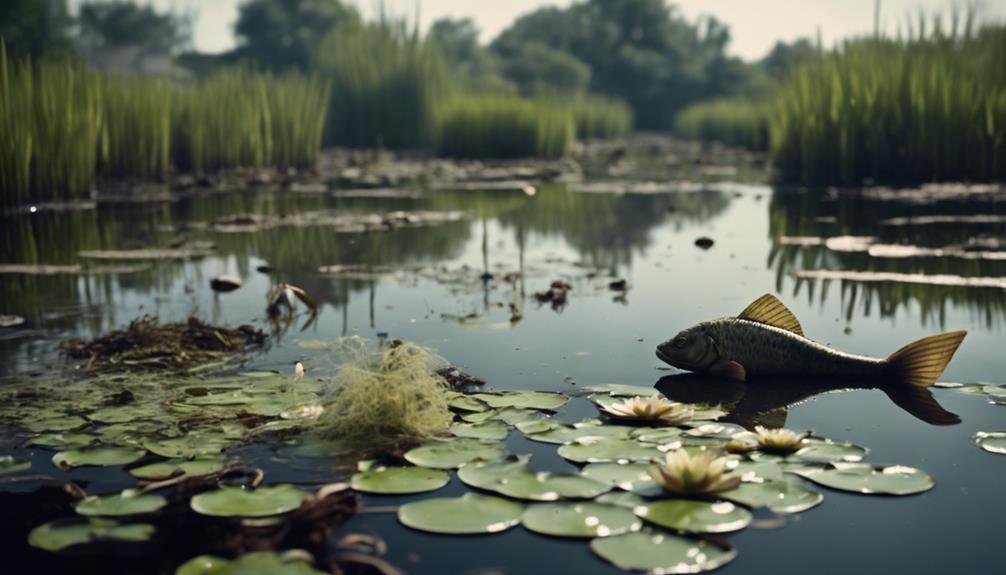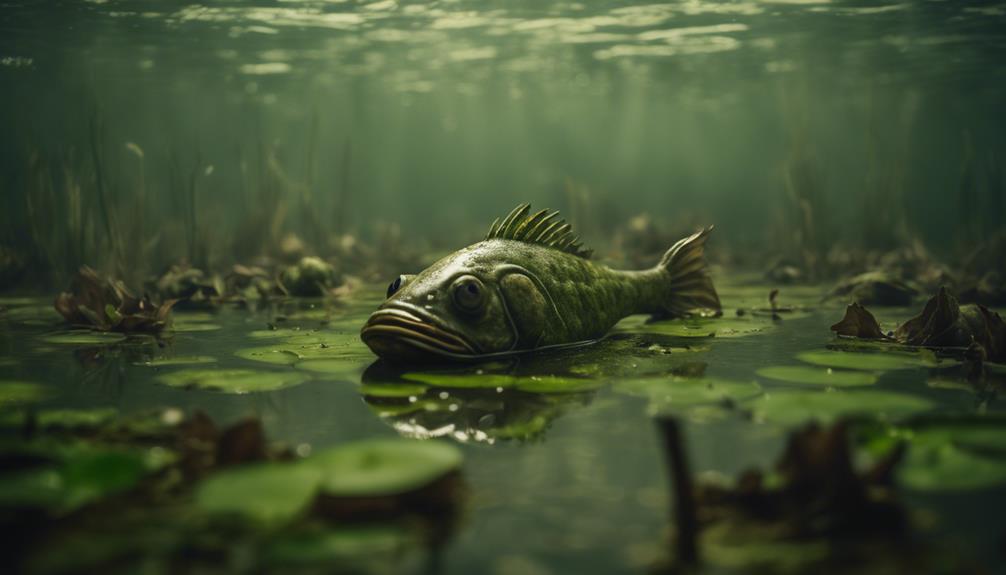You'll likely notice poor pond water quality through a combination of visible signs, including algae blooms, murky or discolored water, and dead fish. Other indicators include changes in water characteristics, such as unusual colors or foam on the surface, and ecosystem imbalances, like a lack of wildlife or dying aquatic plants. Unpleasant odors, fish swimming near the surface, and changes in their behavior can also signal poor water quality. By recognizing these signs, you'll be alerted to potential issues – and taking a closer look will reveal more about what's going on beneath the surface.
Table of Contents
Key Takeaways
- Visible signs of poor water quality include algae blooms, murky water, foam or scum on the surface, dead fish, and lack of wildlife around the pond.
- Murky water appearance indicates excessive algae growth, poor circulation, and oxygen depletion, affecting aquatic life and water quality.
- Low oxygen levels can lead to fish die-off, indicated by fish swimming near the surface, and can be measured by dissolved oxygen levels below 6 mg/L.
- Excessive algae growth and decomposition of organic matter can produce unpleasant water odors, signaling poor water quality and ecosystem imbalance.
- Changes in fish behavior, such as rapid swimming or gathering at the surface, can indicate water quality issues, including low oxygen or toxic substances.
Visible Signs of Pollution
When you gaze out at a polluted pond, you're likely to notice some telltale signs that something is amiss, including algae blooms, murky water, foam or scum, dead fish, and a lack of wildlife.
These visible signs of pollution indicate poor pond water quality, which can have severe consequences for aquatic life and human health.
Algae blooms, for instance, can produce toxins that harm humans and animals alike.
Murky water, often resulting from oxygen depletion, can be a breeding ground for disease-causing microorganisms.
Foam or scum on the water surface signals a buildup of decaying organic matter, while dead fish floating on the surface or washed up on the shore are a stark warning sign of poor water quality.
Additionally, a lack of wildlife around the pond or lake may indicate that the water is polluted, making it uninhabitable for aquatic species.
Water Clarity Issues
When you observe your pond's water, you'll likely notice issues with its clarity, which can manifest in several ways.
You may see a murky water appearance, where the water is thick with suspended particles, or cloudy water conditions, where light can't penetrate.
These issues can ultimately lead to a turbid water state, where the water is so opaque that it's difficult to see even a few inches below the surface.
Murky Water Appearance
You're likely no stranger to the uninviting sight of murky water in your pond, which can be a telling sign of poor water quality.
This unappealing appearance can be attributed to several factors, including:
- Excessive algae growth, which can lead to a thick, greenish scum on the surface of the water
- Poor circulation, causing stagnant water that's prone to algae growth and low dissolved oxygen levels
- Unchecked plant growth, which can release excess nutrients, fueling algae growth and clouding the water
- Inadequate maintenance, resulting in an imbalance of nutrients and oxygen levels, further contributing to murky water
When your pond water is murky, it's not just an aesthetic issue – it can also indicate underlying problems that can harm aquatic life and compromise overall pond water quality.
Cloudy Water Conditions
Cloudy water conditions, often accompanied by a hazy or milky appearance, can be a significant concern for pond owners, as they can indicate underlying problems that compromise water quality and aquatic life.
One possible reason is oxygen depletion, which can be attributed to excess algae growth or poor circulation.
To measure the sediment or turbidity in your pond water, you can use a Secchi disk, which helps determine the water clarity.
If you notice cloudy water, vital action is required to eliminate the source of the problem, such as runoff from disturbed areas or from bottom-dwelling fish and muskrats.
Persistent cloudy water problems can be treated with additions of ground limestone, hydrated lime, gypsum, or alum to clarify the water.
Remember, water clarity is vital for a healthy pond ecosystem, with a minimum of 1-2 feet of visibility recommended.
Turbid Water State
Pond water turbidity, characterized by a murky or opaque appearance, indicates a compromised water clarity state that necessitates prompt attention to prevent detrimental effects on aquatic life and ecosystem balance.
When you notice your pond's water is turbid, it's vital to investigate the cause and take corrective action. A turbid water state can lead to low oxygen levels, which can be fatal to aquatic life.
Some common signs of a turbid water state include:
- Visibility of less than 12 inches when using a Secchi disk
- Excessive algae growth, which can deplete oxygen levels
- Murky or cloudy water that obscures your view of the pond's bottom or aquatic life
- Unpleasant odors or tastes, indicating poor water quality
If you're experiencing any of these issues, immediate action is necessary. Failure to do so can lead to a decline in water quality, harming your pond's ecosystem and aquatic life.
Unhealthy Aquatic Ecosystem

As you assess the poor pond water quality, you'll likely notice an unhealthy aquatic ecosystem.
You'll observe that the ecosystem is struggling due to a lack of oxygen, which can have devastating effects on aquatic life.
Additionally, excessive algae growth will likely be present, further disrupting the delicate balance of the ecosystem.
Lack of Oxygen
Insufficient dissolved oxygen levels in your pond water can lead to a devastating cascade of events, ultimately threatening the very survival of your aquatic ecosystem. When oxygen levels drop, it can have a ripple effect on the entire ecosystem, impacting everything from fish populations to water quality.
Signs that your pond may be experiencing a lack of oxygen include:
- Fish swimming near the surface: When oxygen levels are low, fish may swim near the surface to get more oxygen, making them more susceptible to predators.
- Dead or dying aquatic plants: Without sufficient oxygen, plants can't thrive, leading to a decline in water quality and further exacerbating the problem.
- Unpleasant odors or tastes: Low oxygen levels can lead to the growth of anaerobic bacteria, which can cause unpleasant odors or tastes in the water.
- Increased water temperature: When oxygen levels drop, water temperatures can rise, further stressing your aquatic ecosystem.
As a responsible pond owner, you must monitor oxygen levels through regular lake water testing and take proactive steps to address any water quality problems. This may involve installing pond aerators or implementing other pond management strategies to maintain a healthy and thriving aquatic ecosystem.
Excessive Algae Growth
You're likely to notice excessive algae growth in your waterbody when you see a sudden proliferation of green, slimy mats or pea-soupy water, which can be a telltale sign of an unhealthy aquatic ecosystem.
Excessive algae growth can degrade water quality, making it difficult for other aquatic life to thrive. This occurs when there's an imbalance in plant and algae growth, leading to an algae bloom. Planktonic algae, which are suspended in the water column, can also contribute to this issue.
There are several types of filamentous algae that can grow in your pond, including those that form thick, hair-like strands.
To combat excessive algae growth, consider using a Straw for Algae, which can help remove excess nutrients from the water.
Maintaining a Balanced Pond ecosystem is essential to preventing algae overgrowth. This can be achieved by ensuring proper water circulation, managing nutrient inputs, and introducing beneficial bacteria to break down organic matter.
Abnormal Water Characteristics
What're the telltale signs that your pond water has taken a turn for the worse?
One of the most obvious indicators is abnormal water characteristics. Take a closer look at your pond's water and ask yourself:
Is it murky, with visibility restricted due to oxygen depletion or poor circulation?
Is there foam or scum on the surface, signaling a buildup of decaying organic matter?
Is the water color unusual, such as yellow, green, or brown, indicating high levels of algae, bacteria, or other contaminants?
Is the dissolved oxygen level below 6 mg/L, threatening the very existence of your aquatic life?
These abnormal water characteristics are all red flags that your pond's water quality is suffering. Excessive algae growth, poor circulation, and oxygen depletion can all contribute to these issues.
You must take prompt action to prevent harm to your aquatic life and maintain a healthy ecosystem. By recognizing these signs, you can take corrective action to restore your pond's water quality and create a thriving environment for your aquatic life.
Fish and Wildlife Distress

As you observe your pond's ecosystem, pay attention to the behavior and well-being of its inhabitants, as fish and wildlife distress can be a telling indicator of poor pond water quality.
Dead fish in the lake or pond can be a sign of water pollution, disease, or lack of oxygen, which can lead to poor water quality. A lack of wildlife around the pond or lake may indicate that the water is polluted, as healthy water bodies typically support a diverse range of aquatic life.
If you notice fish and other aquatic animals surfacing frequently, it may be an early sign of low oxygen levels, which can lead to fish die-off if not addressed promptly.
Fish with visible signs of stress, such as labored breathing or erratic swimming, can also indicate poor water quality and low oxygen levels. A sudden change in fish behavior, such as rapid swimming or gathering at the surface, can be a sign of water quality issues, including low oxygen or toxic substances in the water.
Unpleasant Water Odors
When monitoring your pond's water quality, the presence of unpleasant odors can be a strong indicator of an underlying issue, much like the distress signals sent by fish and other aquatic organisms. Unpleasant water odors can be a signal that something is amiss in your pond's ecosystem.
Decomposition of organic material, such as dead fish or plants, can lead to the production of hydrogen sulfide and methane gases.
Anaerobic conditions, characterized by low dissolved oxygen levels, favor the growth of microorganisms that produce volatile organic compounds (VOCs) responsible for the foul smells.
Excessive nutrient levels, particularly phosphorus, can fuel the growth of algae and aquatic plants, eventually leading to decay and malodorous compounds.
Poor water circulation and stagnation allow organic matter to accumulate and decompose, releasing foul-smelling gases.
Frequently Asked Questions
What Indicates Poor Water Quality?
You identify poor water quality when you notice algae blooms, murky appearances, or changes in fish behavior, and test results reveal imbalanced pH levels, oxygen depletion, nitrate buildup, sludge accumulation, or presence of toxic substances, causing cloudy water.
How Do I Fix Poor Water Quality in My Pond?
'Fixing poor pond water quality starts with you! Foster fantastic water circulation, fuel beneficial bacteria, and feature flourishing aquatic plants. Regular maintenance, pond aeration, and algae control promote water clarity, healthy fish, and eco-friendly solutions for a thriving ecosystem.'
How to Check Water Quality in a Pond?
You'll want to conduct regular pond testing, including water sampling, to assess aquatic life, pH levels, oxygen rates, water clarity, and sediment analysis, while monitoring for algae blooms and bacteria counts to maintain a healthy ecosystem.
Why Is My Pond Losing so Much Water?
As you gaze out at your pond's dwindling waters, imagine a treasure chest with a hole in its bottom. You're probably losing water due to a leaky liner, excessive evaporation, or inadequate edges, but don't rule out wildlife visits, human error, underground leaks, excess vegetation, or soil erosion.
Conclusion
As you monitor your pond's water quality, remember that it's essential to catch signs of pollution early.
If you don't, the consequences can be devastating. Take, for instance, the case of Lake Erie's 2014 toxic algae bloom, which left over 400,000 people without drinking water for three days.
Don't let your pond become a breeding ground for pollutants – stay vigilant and take corrective action at the first hint of trouble.

